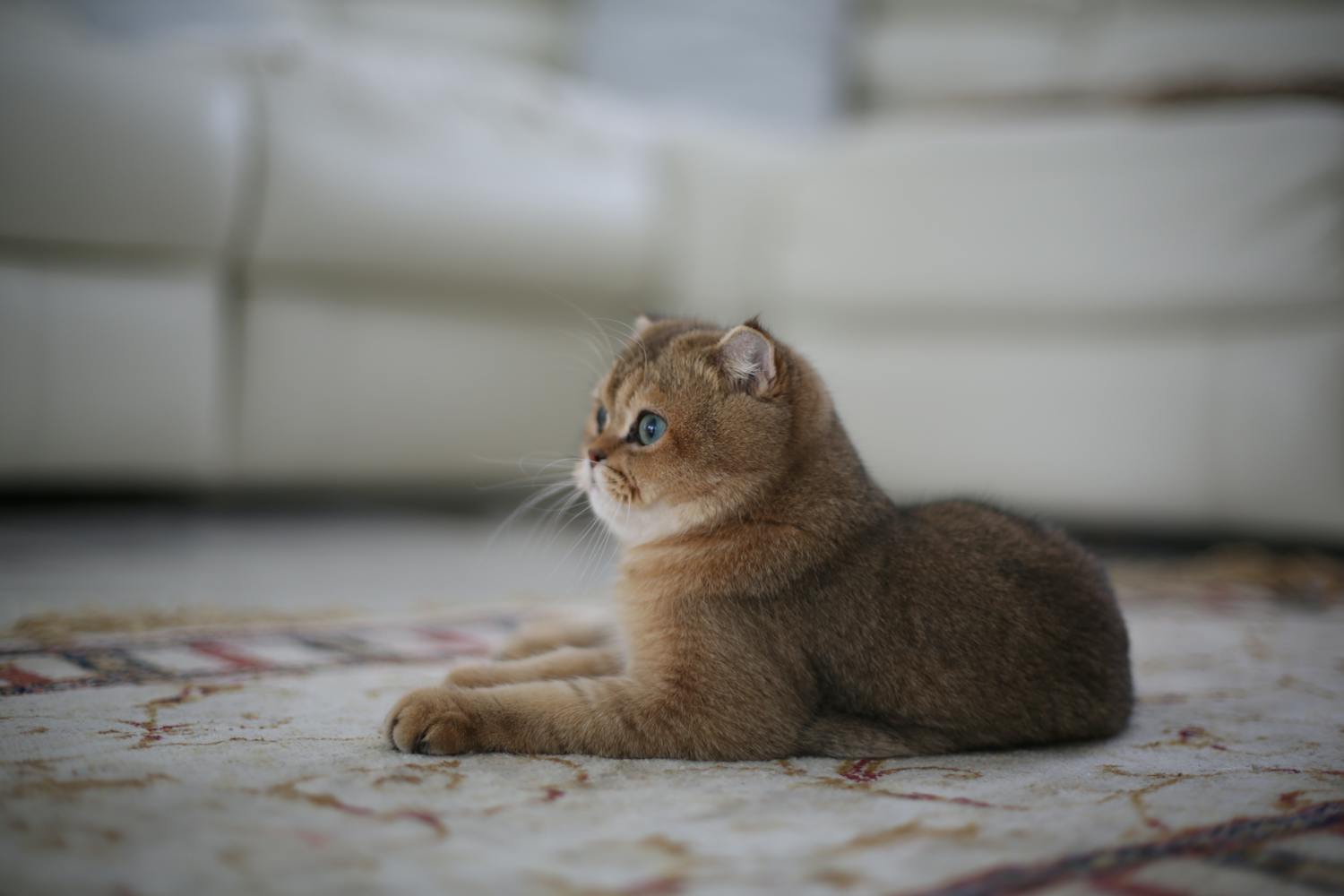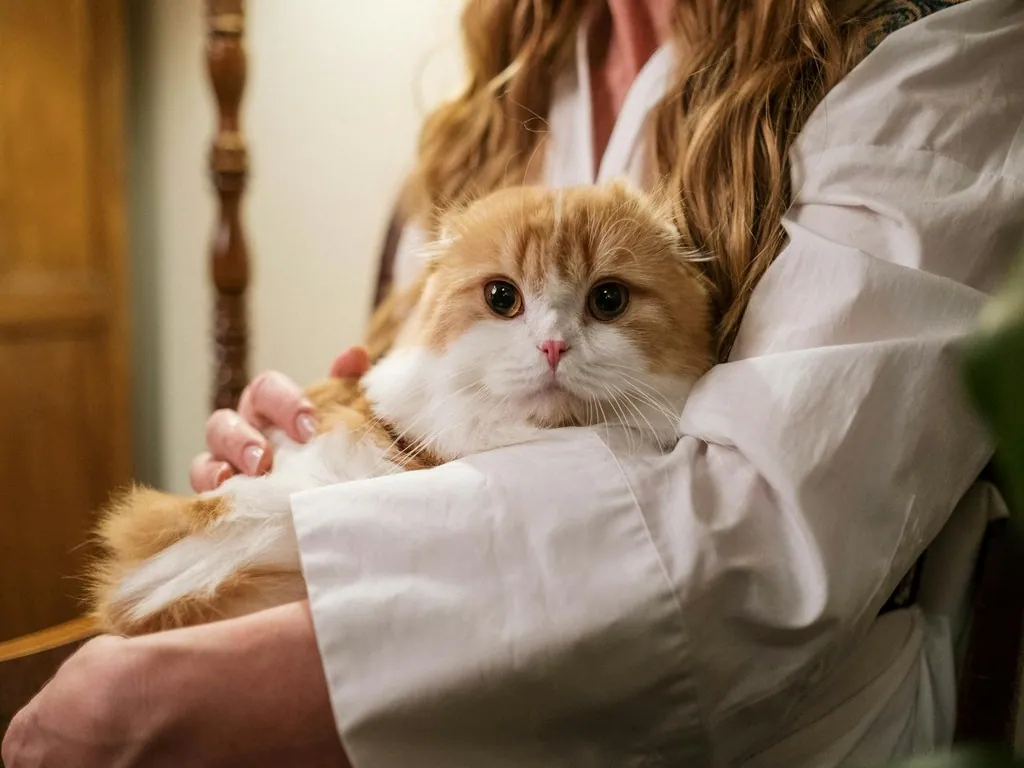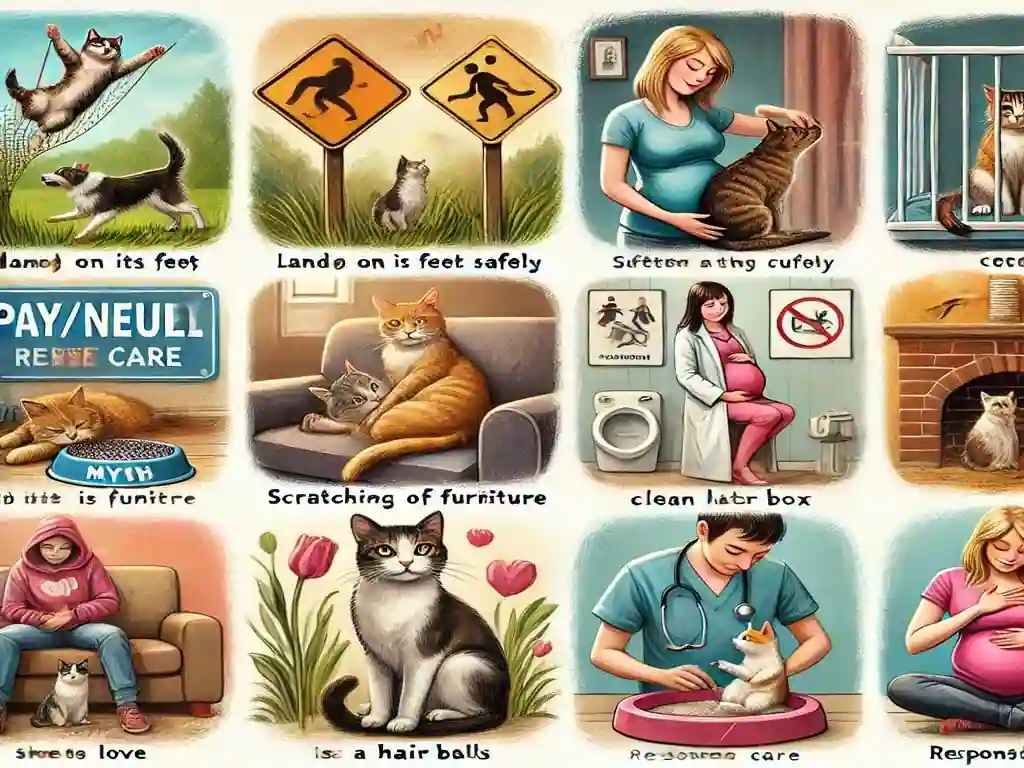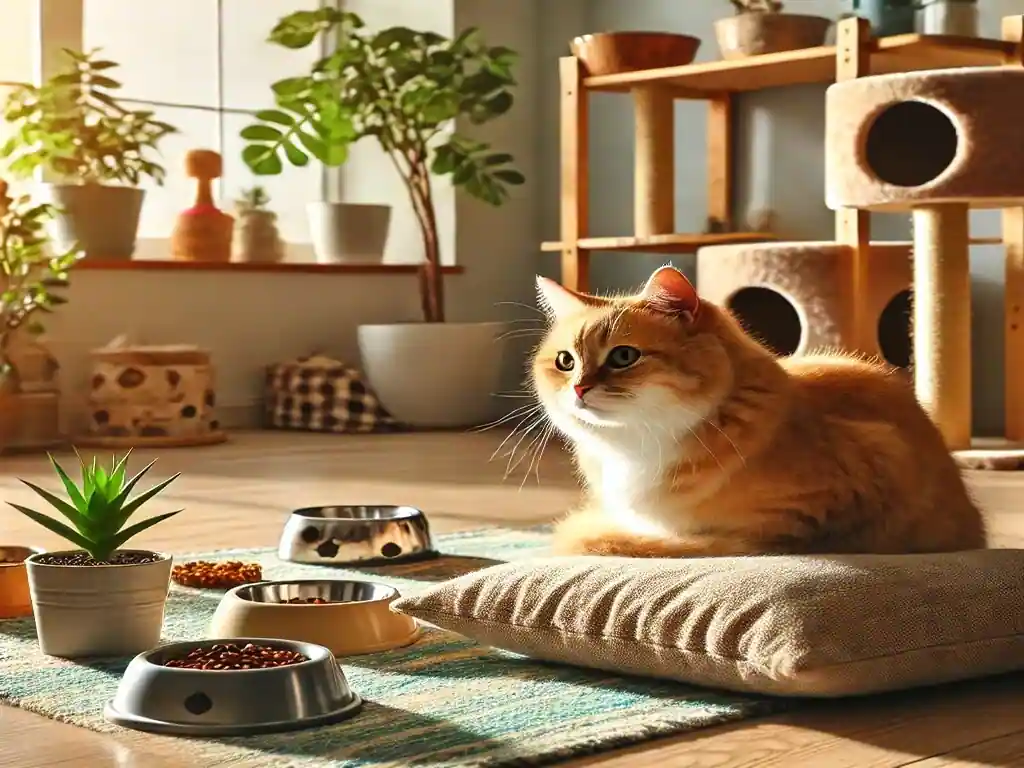CAT
15 Interesting Facts About the Golden British Shorthairs Cat

Quick Guide To Golden British Shorthairs Cat
Golden British Shorthairs are an intriguing breed of cat known for their impressive appearance and outstanding personality. This is a broad look into what you must know about these beautiful cats, from history to special attributes and how they will make great companions.
1. Cat’s Eye—Insider’s Secret.
Probably the most striking features of the type are the eyes. They are large, round, and sometimes referred to as the “cat’s eye,” with colors that range from deep gold to bright copper. The eyes are what form the window to a cat’s soul and reveal just how intelligent and curious it could be.
They contribute vivid coloring to the eyes, therefore creating more beauty in the Golden British Shorthair and enhancing its endearing nature to its owners.
The eyes of this Golden British Shorthair are not merely there to enhance the look; on the contrary, they form a significant part of the cat’s expression and its ways of looking around the world.
Their expression in the eyes may indicate their mood, health, and even the contentment achieved. One easily gets trapped in the expressive stare of a Golden British Shorthair, and the owners grow much attached to such lovely creatures.
2. The Color Code
Golden British Shorthairs are proud of their coat, the epitome of style, and it comes in a wide variety of colors and patterns. The color code is mainly a concern to breeders and fanciers who wish to breed the breed to its exact standards and features.
Colors of Golden British Shorthair cat
Black (n): A few British Shorthairs are black, though less common than some of the other colors. When compared to the golden variations, this is quite dramatic and handsome.
Golden: This is characteristic of a breed and is highly valued for its warmth and depth. It gives a royal and majestic look to the cat.
3. The pattern of the Golden British shorthair cat
Shaded: This pattern includes the gradient effect where the ends of fur are darker to give a shaded effect. The base color in this type is light, hence providing fine contrast.
Spotted: In these British Shorthairs, the spots are spread over the body and look very sporty, and full of life. Spots can be of any size and set anywhere, thereby adding to their uniqueness.
Ticked: In this case, each hair is ringed with different colors, like the ticked or agouti effect. It is one of the wild cat-like patterns that make the breed very exotic.
4. The Earliest Records of Golden British Shorthair Cats in History
The Golden British Shorthair cat is very old. The oldest records confirm that home cats, resembling the breed type, held a significant place in ancient human societies like Egypt and Rome. They were tremendously valued because of their prowess as hunters and companions.
Their independent breed began in the United Kingdom in the 19th century. First called British Blues because of their blue-gray color, this breed of feline had been carefully selected for its stocky build and friendly nature.
Then one fine day, careful breeding again added the golden coloration to make the beautiful Golden British Shorthair we know today.
5. How British Shorthair Cats Became Popular
During the Victorian period, the British Shorthair gained great favor. Even Queen Victoria was a lover of this breed, and that lifted their prestige among the British aristocracy. Their compact build, round face, and plush coat made them very endearing to cat fanciers.
Their popularity kept on growing with their exposure to cat shows and exhibitions. They were so striking to look at – these dignified looks, calm disposition – it made them stand out sharply in a global arena of cat fanciers.
At the turn of the 20th century, British Shorthair cats were being exported to other States of the UK, the USA, and other countries of the world, further expanding their popularity.
6. Official Recognition of British Shorthair Cats
British shorthair was officially recognized by the UK government in 1901. Of course, this was to ensure that the character of the breed was guaranteed and lent impetus to good breeding practices. Indeed, this ensured the guarantee of the breed’s character and lent impetus to good breeding practices.
The Golden British Shorthair variety has been winning its own set of acceptance and appreciation within the feline community for a very long time. It is from them that some of the popular characteristics, like a round face, dense coat, and expressive eyes, became a staple for British Shorthairs.
Currently, Golden British Shorthairs have been noted by many cat associations all over the world to ensure the preservation and continuation of the breed.
7. Orange Tabby British Shorthairs Are Likely to Be Male
One of the more interesting genetic traits in orange tabby British Shorthairs is the fact that most of them appear to be male. The reason behind this is that they have some sort of genetic coding in which the orange color seems to be connected with the X chromosome. A male will then have one X chromosome, so they will show orange if they inherit it. For a female, this would take two copies of the orange gene.
8. Weight Issues in British Shorthair Cats
The British Shorthair is a stockily built cat that loves food. This makes them prone to gaining weight.
Compared to most other breeds, their compact frame and rather sedentary lifestyle can make them obese if their diet is not regulated. Also, cat owners should observe how much food cats eat and provide them with frequent exercise to maintain a fit body. Such cats have to be made to exercise freely and fed with a healthy diet, for obese cats are easily succumbed to many health hazards.
9. A British Shorthair Cat Held the Record for the Loudest Purr
In 2011, a British Shorthair cat named Smokey set the record for the loudest purr astoundingly at 67.7 decibels high. This simply shows that this breed has a loud and happy purring, probably one characteristic most owners find quite endearing and soothing.
In truth, the loud purring by a British Shorthair indeed shows signs of a happy and well-being cat, which could also add to a calming environment within the home.
10. They’re Cultural Icons
British Shorthairs have appeared in everything from literature to billboard ads. Perhaps the most famous of these is the Cheshire Cat from Lewis Carroll’s “Alice’s Adventures in Wonderland,” which many believe was modeled after the breed of the British Shorthair.
Their round faces and smiles were culturally set as characteristic of feline charisma. In addition, British Shorthairs have found their place in plenty of movies, commercials, and artworks which put them at the center of popular culture.
11. Some Do Not Like to Be Held
While British Shorthairs are incredibly affectionate, some do not like being held. These cats seem to be very affectionate in their own right but show it by sitting next to you or cuddling on their own terms.
In any case, a relationship requires respect for personal space and character understanding. Always remember, each cat is special and different from one another; some simply may not have physical contact as part of their nature.
12 . Round Face with Cheeks
One of the attractive features of the British Shorthair is its round face with chubby cheeks. Due to this feature, they continue to look ever-kittenish throughout their lives. Infact, this is the primary reason behind the popularity of this breed.
13. Slow Maturation
These cats take some time to mature; they often take as long as three years to reach their full size and development. The period of slow maturation is one of the reasons behind their compact build and nature.
14. Gentle Giants:
Britain Shorthairs are gentle and tolerant despite their muscular build, so they shall make a very fine companion with children or other pets in the family.
15. Low Maintenance:
Their short, compact coat requires very minimal grooming on their part. So, frequent brushing of their fur tends to reduce shedding, thus keeping the general health of the coat in check. In essence, they have very low maintenance as compared to a breed with long hair.
Conclusion
The Golden British Shorthair is a magnificent breed, supplemented by a great history and a fine physical description. But with the captivating eyes, the luxuriant coat color, and a charming personality, it is hard not to appreciate the breed’s beauty. Whether culturally important, uniquely different, or easy-going by nature, Golden British Shorthairs give companionship and joy to those lucky enough to share life with them.
Any pet will bring with it responsibility in its ownership and toward their welfare, securing a happy, healthy life for your feline friend. You will know what they want and appreciate their peculiarities, thus being able to.
FAQs
Are Golden British Shorthair cats affectionate?
Golden British Shorthair cats are the most calm and laid-back breeds, the British Shorthair is a very undemanding breed. They are loving but not demanding. They will be fine company since they love human company, yet they can stay by themselves, and so they become an extremely adaptive breed to all ways of life.
Are Golden British Shorthair cats suited for busy households?
They will fit into just about any kind of living arrangement, be it apartments or houses with children and other pets. Their ‘take it easy’ attitude makes them very comfortable in both busy households and quiet environments.
How Much Grooming do Golden British Shorthair cats need?
Their short, dense coat requires very little maintenance. Regular brushing reduces their shedding and keeps their coat in good health. They have less matting than the long-haired breeds, which makes them easier to look after.
Are British Shorthair cats Generally Healthy?
Generally, British Shorthairs are sturdy cats blessed with basic good health. They have very long and healthy lives if well cared for. They can have a better life through regular visits to the veterinarian and a fit and balanced diet.
Are British Shorthair cats Loyal pets?
Basically, British Shorthairs are very attached to their owners, loyal, and dedicated. They like to follow their favorite persons around the house, which can offer some sort of comforting presence.
Do British Shorthair cats need socializing?
One should keep in mind that this breed does need some socialization and mental stimulation if one is willing to keep it for oneself.
How Often Should I play with my Shorthair cats?
British Shorthairs love spending time with their human family and enjoy interactive play. Providing a variety of toys and engaging in regular play sessions helps keep them mentally stimulated and physically active.
Cat Breeder Scotland | A Guide to Finding Your Feline Companion
CAT
24 Essential Cat Care Tips to Keep Your Feline Happy and Healthy

Introduction
Being a great cat keeper is all about to assist your cat have a cheerful, blooming and fun life. Indeed small variations in your routine will be enough when it comes to brushing, playing, feeding and getting secure.
The following 24 techniques deal with common cat problems. They prove useful in your daily life, and they even strengthen the bonding between the owner and the cat. The main idea is the improvement of behavioral, health issues, and basic care to give your cat better quality life.
1. Use a Water Fountain to Encourage Hydration
Cats prefer moving water due to their natural instincts. In the wild, running water is safer and cleaner compared to stagnant sources. A water fountain can:
- Draw your cat in with the sound of running water.
- It keeps the water fresher and free from bacteria.
- Encourage more water intake in your cat and it may reduce the risk of kidney and bladder disorders.
2. Place the Fountain Away from the Food Bowl
In nature, cats avoid drinking water near their food source to prevent contamination. Place the water fountain:
- In a quiet, low-traffic area.
- Near a window for a calming view while drinking.
This small adjustment can significantly improve your cat’s hydration habits.
3. Put Some Green Tea Leaves in the Litter Box
Green tea controls smells and fights bacteria. Put dried green tea leaves in the litter box to:
- Eliminate offensive smells without harsh chemicals.
- Keep the area fresh for a longer time.
Tip: Change the tea leaves with each litter change for the best results.
4. Adding Little Baking Soda to the Litter Box
Baking soda has the unique ability to eliminate odor. Simply spread some food-grade baking soda at the bottom of the litter box right before adding fresh litter.
- Absorb remaining odors.
- Keep the litter box fresh much longer.
5. Protecting Surfaces
It is advised to temporarily use foil or double sided tape on the surfaces of tables or counters, in case your cat loves jumping.
Why is it useful?
- Cats dislike the crunchy sound of foil.
- The sticky texture of the tape prevents them from jumping on tables.
These materials can help train your cat to avoid certain areas.
6. Covering Furniture Legs using Sisal Rope
If you are worried that your pet may scratch your furniture legs, the best solution is to wrap the sisal rope around it.
- Satisfies their scratching instincts.
- Protect your furniture.
- Blends well with most home decors.
7. Add Fiber to Their Diet
Formation of hairballs results in digestive problems and irritation. It can be overcome by including fiber in your cat’s diet. You may consider the following alternatives:
- High-fiber cat foods.
- Natural snacks like small amounts of cooked pumpkin. It is advised to consult a vet before making any alterations in the diet pattern.
8. Brush Your Cat Regularly
Brushing your cat twice a week:
- Reduces loose hair and hairballs.
- Strengthens your bond.
- Leaves their coat softer and shinier. Use a brush suited to your cat’s coat type for best results.
9. Create Shelves for Climbing
Cats love to climb and explore. Wall-mounted shelves provide a safe space for:
- Climbing and exercising.
- Relaxing and observing their surroundings. Install shelves at varying heights and ensure they are securely attached.
10. Refresh Old Toys with Catnip
If your cat has lost interest in toys, revive them with catnip. Place the toys in a bag with catnip overnight. This:
- Stimulates their senses.
- Makes old toys feel new and fun. Use fresh, good-quality catnip for the best results.
11. Use an Air Purifier
Use of an air purifier can create good environment in your home because:
- It removes pet odors,keeps it free of dander, and allergens.
- It will make the globe a good place for your pet and family.
12. Familiarize Your Cat with the Carrier
Turn the carrier into a safe haven by:
- Leaving the door open.
- Adding a cozy blanket and favorite toy inside. This helps your cat associate the carrier with comfort, not just vet visits.
13. Get Pet Insurance
Veterinary bills can be quite huge if they are unexpected. While getting pet insurance, it will be confirmed that you can take care of your pet without any budget issues.
14. Protect Plants from Digging
If your cat digs in plant pots, try placing:
- Sticks, rocks, or branches on the soil. This discourages digging and enhances the aesthetic of your plants.
15. Use Natural Repellents
Cats feel irritation towards the odour of citrus and vinegar. Protect plants by:
- Placing orange or lemon peels around them.
- Spraying a vinegar-water mix on the leaves (test first to ensure it’s safe for the plant).
16. Use a Sink for Bathing
Bathing your cat in a sink instead of a bathtub:
- Lessen intimidation due to the smaller space.
- Makes handling easier. Place a towel on the sink bottom to avoid slipping.
17. Use a Flat Plate to Avoid Whisker Stress
Whisker stress occurs when a cat’s whiskers touch the edges of a bowl. Use a flat or shallow plate to:
- Improve their eating experience.
- Reduce food waste.
18. Prevent Toilet Paper Unrolling
Stop your cat from unrolling toilet paper by:
- Securing it with a rubber band or clip.
- Spraying the area with a citrus scent to discourage the behavior.
19. Make a Food Puzzle
Turn an empty bottle into a food puzzle by:
- Cutting small holes in it.
- Filling it with kibble. This slows down eating, aids digestion, and keeps your cat entertained.
20. Train Your Cat with a Clicker
Positive reinforcement works wonders with cats. Use a clicker and treats to:
- Mark desired behaviors (e.g., getting off furniture).
- Reward compliance with a treat. With patience and consistency, you can train your cat effectively.
21. Use a Pheromone Diffuser
Pheromone diffusers help calm cats during stressful situations such as:
- Moving.
- Introducing a new pet or family member.
- Storms or fireworks.
22. Draw a Chalk Circle Around the Food Dish
Chalk contains compounds that bugs avoid. Draw a circle around your cat’s food dish to keep pests away.
23. Place the Dish in Water
In order to keep insects away from the food items, keep it in a shallow tray of water. Ensure the water level doesn’t bother your cat.
24. Neutralizing Urine Stains
If your cat has an accident, clean it quickly using:
- Use vinegar for purifying and killing germs.
- Use of baking soda can offset the smells. Spread a small amount of baking soda on the respective part after the application of vinegar, let it settle, and clean it away.
FAQs
1. What is the frequency for brushing my cat?
Brush your cat two times a week to remove loose hair, stop tangles, and reduce shedding. Brushing also stops hairballs and keeps the coat shiny and healthy.The long-haired cat will often need more frequent grooming to prevent mats.
2. Can I use regular baking soda in the litter box?
Yes, you can indeed use food-grade baking soda in the litter box, but be sure to use them in moderation because excesses can irritate your cat’s paws or even their respiratory system. The end.
3. Are natural repellents safe for my cat?
Natural deterrents like citrus peels and diluted vinegar are relatively nontoxic, though these need to be placed in a well-ventilated area, as they are poisonous if ingested by your feline pet, away from food or water sources. Do a patch test to check on whether your cat is going to react badly to these deterrents.
4. How do I train my cat with a clicker?
Use a clicker and mark the desired behavior as soon as it happens. Immediately reward him with a treat. Over time, this will always enable your cat to associate the sound with rewards. Remember, be patient and use short, fun training sessions.
5. What’s the best way to bathe a cat?
Place a towel in a sink or tub so it won’t slide around, and use warm water and mild pet shampoo. Bathe your cat slowly, keeping away from their face, and rinse well. Gently pat them dry with a towel and give them a treat afterwards for a good experience.
Also read: https://skystylus.com/debunking-9-most-common-cat-myths
CAT
Debunking 9 Most Common Cat Myths: Eye-Opening Facts About Feline Behavior and Care

Introduction
Cats are quite interesting, yet over the ages, so many myths have come to shroud our knowledge about these marvelous pets. Although some of the myths may not affect people adversely, others might badly influence the manner in which individuals perceive and relate to cats.
This article endeavors to debunk the truth about 9 most common cat myths and illustrate how knowledge of facts can help in improving the human-cat relationship.
1. Cats always land on their paws
First of the 9 common cat myths is that they have some kind of magic that allows them to land on their feet regardless of the distance they fell. This myth, though originating from their amazing air-righting reflex, is very misleading. This reflex does help the cats twist their bodies mid-air in an attempt to land safely, but it’s not infallible.
They do not have enough time to reposition themselves in cases of short falls, and they are likely to suffer serious injuries, such as fractures and internal damage, with very high falls. Protect your cat from falling by setting safety nets on windows and balconies, supervising them in elevated areas, and providing safe stimulation indoors to avoid risky behavior. It is one’s responsibility, reflecting true love and care for a cat’s safety.
2. Cats Scratch Everything
Many prospective cat owners are concerned that their homes will be turned into a scratching war zone. However, scratching is an instinctive and necessary behavior in cats, not a form of rebellion or meanness.
Three reasons why cats scratch:
- Marking Territory: They leave visual marks and pheromones to claim ownership of a space.
- Nail Care: Scratching helps remove dead nail layers and keep claws healthy.
- Stretching and Strengthening: This activity will help contribute to their physical fitness and flexibility.
To protect your furniture, place scratching posts that have the favorite textures of your cat, such as cardboard or sisal, strategically near areas where your cat is already scratching. Reward your cat for using the posts by praising them, and use double-sided tape on the furniture temporarily.
3. Cats are unkind and treacherous
The stereotype that cats are cold or selfish has wronged these friendly animals. While cats are instinctively independent – unlike dogs-they are usually misconstrued as aloof.
Studies, such as those conducted at Oregon State University, show that cats form deep bonds with their owners, similar to the attachment children feel toward caregivers. Cats express affection uniquely, such as purring, rubbing against your legs, or giving “cat kisses” with slow blinks. Building trust with a cat requires patience, but the reward is a loving relationship based on mutual respect.
4. Pregnant Women Should Avoid Cats
Among the widespread common cat myths about cats is that pregnant women should leave their cats behind since the parasite can be transmitted through them. However, the risk of infection with toxoplasmosis from a well-cared-for cat is very low.
The parasite is actually acquired from the ingestion of undercooked meat, contaminated water, or even unwashed fruits and vegetables and not from cats directly. Even common hygiene measures, such as the regular cleaning of the litter box, proper washing after it’s been touched, and a balanced diet containing commercial or cooked food, reduce the risk nearly to zero. Pregnant women can retain their pet cats.
5. Cats Don’t Get Along With Dogs
This idiom has enabled the misconception to linger that cats and dogs are one another’s enemies. Though they portray a different form of behavior and body language, cats and dogs may be friends provided they meet well.
Start by gradually exposing them to each other’s scent and create safe havens separate from one another. Observe the introduction carefully, and once everything is calm and respectful, reward. Cats and dogs can become best buddies, all through patience and proper introduction.
6. Cats Can’t Learn Tricks
Among common cat myths is the one that the cats lack the ability to learn tricks like other pets. This is far from the truth since, although cats may not as easily exhibit enthusiasm to please their owners like canines do, cats are intelligent and curious animals that can learn tricks with the right motivation.
Great to have some positive reinforcement like treats or sweet words. The training sessions should be kept short and interesting for them as per their attention span. Tricks are a good way to stimulate your cat’s mind and also strengthen the bond between you and your feline friend.
7. It’s Normal for Cats to Pass Hairballs Often
Hairballs seem like a normal thing to happen in cats, but repeated instances of them may indicate some underlying health issues. Cats naturally groom themselves by swallowing hair, and this usually comes out with the digestive process.
Hairballs vomiting more than usual might be a symptom of excessive grooming resulting from stress, shedding, or skin problems. Prevent hairballs by brushing the cat regularly, giving it a fiber diet, and hydrating it. Bring the cat back to a veterinarian for follow-up treatments if hairballs persist, with the aim to ensure that she does not incur intestinal blockage.
8. Cats cannot love their human owners
Science has proven contrary to popular thought that says cats are uninterested as they possess secure attachments with their owners. They love quietly by purring, rubbing themselves against you, or sleeping next to you.
It often is misunderstood as aloofness; it just proves that the cat is an independent animal and it’s not a lack of love. Research has proven it reduces stress; improves cardiovascular health and gives companionship when living with the cat. They are very affectionate creatures but express it in such a subtle and meaningful way.
9. Cats Should Be Mothers at Least Once
Most damaging of the 9 common cat myths is that cats have to give birth to kittens to be fulfilled. In reality, cats, unlike human beings, are not driven to procreate due to emotional needs. Permitting a cat to have kittens does nothing to improve her quality of life; she is needlessly exposed to health risks.
The most significant benefits include prevention of overpopulation and decreasing the risk for some diseases like uterine infections and cancers. It’s the responsible way toward better health in general for both your pet and the feline population.
Endnote
Cats are wonderful, but myths and misconceptions oftentimes lead one astray. Let’s address some of those myths and lay the truth upon them so one can better care for and adore these wonderful furry friends.
Do you have any other cat myths except for these 9 common cat myths that we should hear in the comments below? The adventure continues with discovering the truth behind these animals.
Also read: https://skystylus.com/how-to-transition-your-cats-diet
CAT
10 Things I Wish I Knew Before Bringing a Cat Home: Expert Advice for First-Time Cat Parents

Introduction
Bringing a cat to live with you is the milestone for many, yet comes with its own difficulties. Cats are interesting pets and present unique needs and behavior patterns, and most importantly, understanding these small aspects would make all the difference to create a warm house.
Based on my 30 years of experience as a cat owner, I have outlined these few tips that I wish had come early in my kitty rearing days. In this guide we will cover 10 things I wish I knew before bringing a cat home will help you prepare for a joyful and enriching relationship with your new feline friend.
1. Introducing Cats to Other Pets
A step by step approach, patience and proper preparation is essential before introducing your cat to a new pet. It is more than just “letting them sort it out.” A well planned introduction can avoid stress and the chances of conflict.
For Dogs
- It is necessary that you dog understands the basic commands of obedience like sit, stay prior to introduction to a cat
- Leash them initially to make sure they don’t cause chasing behavior, which sometimes frightens the cat, and sometimes leads to years of tension.
For Other Cats:
- Create separate spaces with separate food, water, and litter resources for both cats during the adjustment phase.
- Use scent-swapping by exchanging bedding or toys between them to help them acclimate to each other’s scents before they meet each other face-to-face.
Pro Tip: Many Internet resources and tutorials offer easy step-by-step instructions regarding how to introduce cats to other pets. Check out the video guides for more helpful information!
2. Maintaining Boundaries: Litter and Food
The needs of cats and dogs differ when it comes to requirements like food and litter. Without proper management, it creates a hub for conflicts and health issues.
- Litter Box Access: Dogs consider litter boxes as snack bars (gross, but true). Prevent this by putting litter boxes in areas accessible to cats but out of reach for dogs—like behind baby gates or on higher levels.
- Food Separation: Cats are obligate carnivores and should not eat dog food, as it lacks essential nutrients like taurine. Similarly, dog diets are not formulated for cats. Feed them in separate spaces to ensure each pet has access to the right nutrition.
3. Regular Nail Trimming
If the cat’s nails are neglected, then painful problems can arise such as when overgrown claws dig into the paw pads. Trims every 3–4 weeks prevent injuries, damage to furniture, and those nasty scratches.
- Start trimming when your cat is young and make it a routine.
- Use cat-specific nail clippers, and reward them with treats so they associate them with pleasant experiences.
4. Understanding Proper Nutrition
Other animals have drastically different nutritional requirements than domestic cats. Indeed, these are obligate carnivores and, consequently, thrive on meat.
- Wet food vs. dry food: Wet food is closer to their natural diet and adds hydration. Cats rarely drink enough water, but with wet food they avoid dehydration and urinary tract problems.
- High-Quality Brands: Opt for reputable brands with real meat as the first ingredient. Avoid foods with fillers like corn or soy, which have minimal nutritional value.
Lesson Learned: My first cat developed diabetes because of the unbalanced diet. Always consult your vet for recommendations on what to feed your cat.
5. The Importance of Enrichment
In comparison to dogs, cats comparatively require low maintenance. But still, they need a lot of physical & mental stimulation to really prosper.
- Daily Play Time: Engage them in interactive play by distributing toys such as wand teasers or laser pointers for physical activity.
- Catification: Cats love climbing and perching. Install shelves, provide scratching posts, and invest in a sturdy cat tree to give them spaces to explore and feel safe.
Enrichment is not only about keeping your cat entertained but also regarding a mental health matter.
6. Cat-Proofing Your Home
Cats are natural explorers, but sometimes this may end them in trouble. To avoid any mishap, you have to make your home cat proof.
- Secure Hazards: Lock cabinets to a child-resistant state so that cleaning products, medications, or other toxic materials are inaccessible.
- Eliminate Dangers: Hide electrical cords, remove poisonous plants, and block off small spaces where your cat could get stuck.
- Keep Valuables Safe: Cats love to knock things over—secure breakables or place them out of reach.
7. Building a Support Team
Having a reliable support system is essential when you’re a pet owner. Whether it’s for routine care or emergencies, establishing connections with professionals will make your life easier.
- Veterinarian: Choose a vet to research on before taking your cat home. Seek reviews and referrals from pet owners.
- Find pet sitters: Find sitters who are bonded and insured; some cat owners also employ such service to cater for their cat’s needs.
8. Investing in Pet Insurance
It is a very wise approach to insure your cat. Otherwise, bills especially veterinary costs can become a burden
- What to Look For: Consider a plan that provides security for injuries, sickness and routine care. Consider parameters such as monthly premiums, debits and compensation rates.
- Start Early: It is advised to apply for insurance as soon as possible, because the conditions a cat suffering prior to insurance are usually exempted.
9. Emergency Preparedness
Caution is better than cure. So, it is much better to make a plan for the safety of yours cat before a random disaster.
- Emergency Kit: Prepare a go-bag of food, water, medicines, and a copy of the medical records of your cat.
- Familiarization with Carriers: Allow your cat to associate their carrier with pleasant experiences by leaving the door open at home and occasionally placing treats inside. This helps to minimize fear during emergency or vet visits.
10. Understanding the History of Cats
Cats’ behavior today is deeply rooted in their evolutionary history. Knowing more about their instincts can help you address behavioral issues.
- Scratching: This behavior is not about destruction; it’s the way cats mark their territory and keep their claws healthy. Offer scratching posts to channel this behavior.
- Climbing: In the wild, cats climb to escape predators and survey their surroundings. Giving your cat vertical spaces satisfies this natural urge.
Understanding your cat’s needs isn’t about following the rules; it’s about fostering a deeper bond.
Conclusion
In the end, it is an amazing experience to bring a new cat home, but without proper preparation, all this may be reversed. By following all the tips given above, you can better be able to familiarize your cat with other pets in the house.
Final Tip: Keep curious and keep learning. There is so much more to learn about becoming the best cat parent ever. Resources abound to help you get there. Here’s to many joyful moments with your new furry friend!
FAQ Section 10 Things I Wish I Knew Before Bringing a Cat Home
1. How do I introduce my new cat to my dog?
Try to keep them separate at the start and make a gradual introduction. In case, you are making a face to face interaction with a dog, use a leash and reward them to calm their behaviours.
2. Should I get pet insurance for my cat?
Surely, it can help to compensate for random medical costs that provide financial relief during emergencies.
3. What kind of food should I feed my cat?
As cats are carnivorous by nature, giving wet food impersonates their natural diet and keeps them hydrated. While high standard kibble can supplement their meals.
4. How often should I trim my cat’s nails?
Every 3-4 weeks to avoid excessive growth of nails.
5. How can I enrich my indoor cat’s life?
Toys such as puzzles and cat trees can engage them in physical activities that keep them mentally sharp as well.
Top 10 Warning Signs Your Cat Might Be Sick: Dr. Sarah Wooten’s Expert Guide for Feline Health









Pingback: Dog Bark Law in Different Countries | Skystlus.com - skystylus.com
Pingback: The Comprehensive Guide to Gray Husky Puppy: Puppies, Prices, Care and More - skystylus.com
Pingback: How to Care for a Chocolate Persian Cat: Essential Tips on Grooming, Diet, and Health - skystylus.com
Williamgef
August 14, 2024 at 11:56 pm
новые проститутки нижний новгород
Kevindub
August 17, 2024 at 3:13 am
зрелые проститутки
BrianRaike
August 20, 2024 at 9:16 pm
индивидуалки иркутск частные объявления
RobertFag
August 21, 2024 at 9:23 pm
шлюхи иркутска на выезд
BennyTal
August 23, 2024 at 1:14 am
снять шлюху иркутск
avenue17
October 21, 2024 at 5:06 pm
It agree, very good message
Alvinvitle
October 22, 2024 at 4:39 pm
https://telegra.ph/Ros-Car-Podgorica-Your-Premier-Car-Rental-Choice-in-Montenegro-09-29
Robertzix
November 4, 2024 at 9:33 pm
https://virtual-local-numbers.com/countries/32-usa.html
Admin
November 5, 2024 at 2:43 am
WE CHARGE FOR THIS LINK
StephenHop
November 21, 2024 at 1:30 am
https://infobriz.com.ua/rizne/ventylyacziya-bagatokvartyrnogo-budynku-perevagy-spivpraczi-z-profesionalamy/
Richardled
November 26, 2024 at 1:10 am
раскрутка в соцсетях
Brandontes
December 1, 2024 at 4:39 am
https://pastelink.net/ou5eld24
Arthurspunk
December 14, 2024 at 10:28 pm
https://pq.hosting/vps-vds-ireland-dublin
Dominicdab
December 26, 2024 at 12:12 am
https://www.volkswagenownersclub.com/members/findytripcom.280809/
Robertgaw
January 18, 2025 at 7:09 am
http://sniperprojects.freehostia.com/e107_plugins/forum/forum_viewtopic.php?735003.last